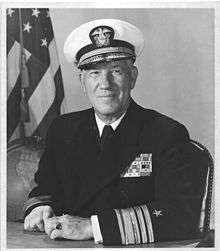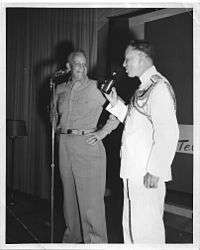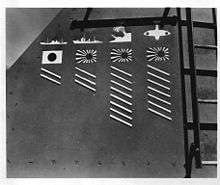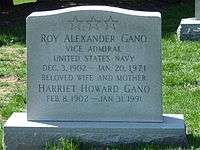Roy Alexander Gano
| Roy Alexander Gano | |
|---|---|
 Vice Admiral Roy A. Gano, 1963 | |
| Nickname(s) | "Red" |
| Born |
December 3, 1902 Pipestone, Minnesota |
| Died |
January 20, 1971 (aged 68) Falls Church, Virginia |
| Buried at | Arlington National Cemetery |
| Allegiance | United States of America |
| Service/branch | United States Navy |
| Years of service | 1922–1964 |
| Rank | Vice Admiral |
| Commands held | Military Sea Transportation Service (1959-1964) |
| Battles/wars |
World War II Korean War |
| Awards |
Navy Cross (2) Navy Distinguished Service Medal Legion of Merit (2) Bronze Star (2) |
Roy Alexander "Red" Gano (December 3, 1902 – January 20, 1971) was an Admiral of the United States Navy who distinguished himself in World War II, Korean War, and the Cold War, and served as Commander Military Sea Transportation Service (now Military Sealift Command) and as Executive Director for Ocean Transportation from 1961 to 1964.
Early life and career, through 1941
A native of Pipestone, Minnesota, Gano attended the United States Naval Academy and graduated in 1926. He returned to the Academy as a postgraduate student in 1934.
He married Harriet Pauline Howard, July 18, 1929. Admiral and Mrs. Gano had 2 children, Myrtle Eugenia "Jeanne" Gano Steele born May 29, 1940 and deceased September 19, 2006, and James Alexander Gano born April 1, 1946 and deceased November 11, 2005. Gano spent much of his early career at sea. He served first in the battleship USS Tennessee (BB-43), 1926–29, then was assigned to several destroyers: USS John D. Edwards (DD-216), 1929–30; USS Edsall (DD-219), 1930–31; USS MacLeish (DD-220), 1931–32; and as Engineer on board USS Dewey (DD-349), 1934-37.
From 1937-1939, he served as Special Engineer, United States Navy Research Lab, Bellevue, Washington. In 1941, he was assigned as Material Officer and Commander, Destroyer Battle Force.
World War II and postwar period
Gano spent the first part of the war in seagoing commands. He served as Material Officer and Commander, Task Force 8, Alaska, 1941–42; and Commander of the destroyer USS Dyson (DD-572), 1942–44, in Destroyer Squadron 23. The latter squadron, known as the "Little Beavers", covered the initial landings in Bougainville in November 1943, and fought in 22 separate engagements during the next four months. During this time, the Little Beavers were credited with destroying one Japanese cruiser, nine destroyers, one submarine, several smaller ships, and approximately 30 aircraft. Destroyer Squadron 23 earned a Presidential Unit Citation, which said in part:
For extraordinary heroism in action against enemy Japanese forces during the Solomon Islands Campaign, from 1 November 1943 to February 23, 1944... Destroyer Squadron Twenty-three operated in daring defiance of repeated attacks by hostile air groups, closing the enemy's strongly fortified shores to carry out sustained bombardments against Japanese coastal defenses and render effective cover and fire support for the major invasion operations in this area ... The brilliant and heroic record achieved by Destroyer Squadron Twenty-three is a distinctive tribute to the valiant fighting spirit of the individual units in this indomitable combat group of each skilled and courageous ship's company...
For the remainder of the war, 1944–1946, he served as Assistant Director, United States Navy Communications for Administration, Office of the Chief of Naval Operations, Washington, D.C.
From 1946-1948, Gano served as Commander, Destroyer Squadron 5, also Destroyer Division 51, Japan-Korea area, 1946-48. He then returned to shore duty as Director of Recruiting, Bureau of Naval Personnel, 1948–50; then as Director, Enlisted Personnel Division, 1950-51.
Korean War through retirement
He returned to sea in 1951 as Commander of the cruiser USS Saint Paul (CA-73), deployed to Korea, a command he held until 1952. He was then assigned as Chief of Staff and Aide to the Commander, Service Force, U.S. Pacific Fleet, 1952–54; Commander, Service Squadron 3, in the evacuation of refugees from Northern Indochina, 1954;
In 1954, Gano was promoted to Vice Admiral, and was assigned as Assistant Chief for Logistics, holding that position until 1955. He then served as Deputy Chief of Staff for Administration, Far East and U.N. Commands, 1955–56; Deputy Commander, Military Sea Transportation Service, 1956–58; Commander, Amphibious Group 2, 1958–59; and Commander, Military Sea Transportation Service, 1959-64.

Admiral Gano retired from active duty in 1964 and then served as Vice President of Moore-McCormack Lines, Washington, D.C., 1964-71. He also served as President and Chairman of the Board of United Seamen's Service from 1961 to 1971. In 1969 Admiral Gano was elected Chairman of the Board of Hamilton Bank & Trust Company, based in Bailey's Crossroads,VA, where he was a Director until his death.

Awards and honors
During his career, Admiral Gano was awarded the Bronze Star with gold star, the Navy Cross with gold star, Legion of Merit with gold star, and the Navy Distinguished Service Medal.
Navy Distinguished Service Medal: The President of the United States of America, takes pleasure in presenting the Navy Distinguished Service Medal to Vice Admiral Roy Alexander Gano, United States Navy, for exceptionally meritorious and distinguished service in a position of great responsibility to the Government of the United States during the period 1 June 1961 to 30 June 1964, as Executive Director for Ocean Transportation and as Commander Military Sea Transportation Service. Responsible for directing the complex military logistical sea lift operations of the Department of Defense, Vice Admiral Gano succeeded in improving the responsiveness of the military sea lift in emergencies; enhanced the understanding of the complementary roles of military and merchant shipping to provide greater readiness to meet emergency demands; and made available and effectively utilized ocean shipping to meet military requirements promptly and efficiently during the Berlin build-up, the Cuban crisis and the critical periods in Southeast Asia. By his brilliant leadership, professional competence, and steadfast devotion to duty, Vice Admiral Gano rendered valuable and distinguished service and contributed greatly to the security of the United States.
Navy Cross: The President of the United States of America takes pleasure in presenting a Gold Star in lieu of a Second Award of the Navy Cross to Captain Roy Alexander Gano, United States Navy, for extraordinary heroism and distinguished service in the line of his profession as Commanding Officer of the Destroyer U.S.S. DYSON (DD-572), attached to Destroyer Squadron TWENTY-THREE (DesRon 23), during a night engagement with the six enemy Japanese warships off Bougainville, British Solomon Islands, during the Battle of Empress Augusta Bay on 24 and 25 November 1943. Seeking out and fearlessly engaging a powerful enemy, Captain Gano fought his ship with resolute courage and daring aggressiveness, frequently risking his own personal safety to press home vigorous, unrelenting attacks upon Japanese surface forces. By his extreme valor and inspiring leadership, he evoked the indomitable fighting spirit which enabled the gallant officers and men under his command to contribute materially to the crushing defeat imposed upon the enemy in the sinking of four ships and the serious damaging of two others. An expert seaman and tactician, Captain Gano retired the DYSON from the engagement without loss or damage and his high devotion to duty and splendid conduct throughout the action were in keeping with the highest traditions of the United States Naval Service.
Navy Cross: The President of the United States of America takes pleasure in presenting the Navy Cross to Captain Roy Alexander Gano, United States Navy, for extraordinary heroism and distinguished service in the line of his profession as Commanding Officer of the Destroyer U.S.S. DYSON (DD-509), during an engagement with Japanese naval forces at Empress Augusta Bay, off Bougainville, Solomon Islands, on the night of 1–2 November 1943. With his Task Force engaging a Japanese surface force of superior fire power, Captain Gano hurled the full fighting strength of his ship against the enemy and, by his inspiring leadership and skilled combat tactics, aided his Task Force in sinking five hostile warships, in damaging four others and in completely routing the enemy, thereby contributing materially to the successful establishment of our beachhead on Bougainville Island. His determination, relentless fighting spirit and gallant devotion to duty upheld the highest traditions of the United States Naval Service.
Legion of Merit with Combat V: Awarded for Actions during World War II: Captain Roy Alexander Gano, United States Navy, was awarded the Legion of Merit with Combat "V" for exceptionally meritorious conduct in the performance of outstanding services to the Government of the United States during World War II.
Legion of Merit: Awarded for Actions during the Cold War: Vice Admiral Roy Alexander Gano, United States Navy, was awarded a Gold Star in lieu of a Second Award of the Legion of Merit for exceptionally meritorious conduct in the performance of outstanding services to the Government of the United States.
 Navy Cross with Gold Star
Navy Cross with Gold Star Navy Distinguished Service Medal
Navy Distinguished Service Medal Legion of Merit with Gold Star
Legion of Merit with Gold Star Bronze Star with Gold Star
Bronze Star with Gold Star
The Admiral died on January 20, 1971 and was buried with full military honors in Section 5 of Arlington National Cemetery. His wife, Harriet Howard Gano (February 8, 1902-January 31, 1991) is buried with him.
This article contains information from the Naval Historical Center and is in the public domain.


External links
- Legion of Merit - Criteria, Background, and Images
- Biography, United States Navy
- Legion of Valor
- "Roy Alexander Gano". Find a Grave. Retrieved 2008-01-26.
- Wikipedia Find a Grave
Bibliography
- McLendon, Winzola (1964). "Admirals Setting Sail for Retirement Day." Washington Post and Times Herald. June 21.
- (2006). "Roy Alexander Gano." Arlington Cemetery. Retrieved September 27, 2007.